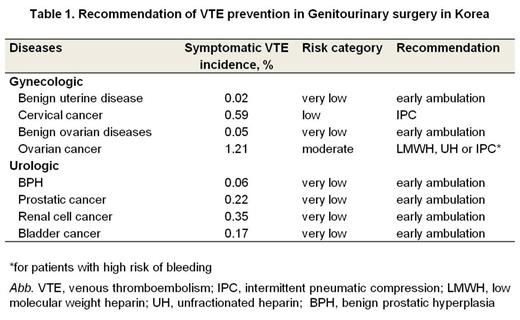Abstract
Venous thromboembolism (VTE) is a major cause of morbidity and mortality after gynecologic and urologic surgeries and previously reported VTE incidence in major genitourinary surgery without VTE prophylaxis was 15-40% in Western countries. VTE is a preventable complication using thromboprophylaxis, however, pharmacologic thromboprophylaxis after major abdomino-pelvic surgery may involve serious bleeding complication. Here, we evaluated the exact incidence and risk factors of VTE following major genitourinary surgery in Korean patients and proposed evidence-based VTE prevention guidelines in such patients.
In March 2012, the committee for the development of guidelines for preventing VTE in Korea was organized by receiving recommendations from the VTE working party members in the Korean Society on Thrombosis and Hemostasis (KSTH). Using nation-wide date from Korea Health Insurance Review and Assessment Service (HIRA) from 2007 to 2011, symptomatic VTE frequencies after major genitourinary surgeries were retrospectively collected and evaluated. For the categorization of those patients by their VTE incidences, we used the methods described in AT9 guidelines (American College of Chest Physicians Evidence-Based Clinical Practice Guidelines, 9th ed.)
According to the HIRA database, 255,324 and 85,191 patients' data were collected and evaluated their incidence of VTE and risk factors, which underwent major gynecologic and urologic surgeries, respectively. In detail, there were 87,136 hysterectomies for benign uterine diseases (76,284) and uterine cervical cancer (10,852), 168,188 oophorectomies for benign ovarian diseases (156,697) and ovarian cancer (11,491), 35,970 prostatectomies for benign prostatic hyperplasia (BPH, transurethral, 26,590) and prostatic cancer (retropubic, 9,380), 12,462 nephrectomies for renal cell cancer and 36,759 radical cystectomies for bladder cancer. As shown in Table 1, most Korean patients undergoing genitourinary surgeries were identified as very low VTE risk category. In the aspect of gynecologic cancer surgery, ovarian cancer showed highest rate of VTE incidence (1.21%, moderate risk; 0.70% deep vein thrombosis, DVT + 0.51% pulmonary embolism, PE) and cervical cancer showed 0.59% (low risk; 0.47% DVT + 0.12% PE). On the basis of these data and a literature search results, the recommendation was made by a consensus of the guideline development committee. To take the advice of outside experts, survey and review for the developed guidelines were performed by other KSTH members and the related Academic Societies.
Even when considering relatively lower incidence of VTE in Asian people than that in Western, Korean genitourinary surgery patients revealed very low incidence of VTE. As stated above, abdomino-pelvic surgery is a procedure for high risk of bleeding complications. Therefore, it is reasonable to assume that the recommendation of pharmacologic thromboprophylaxis for other gynecologic surgeries except ovarian cancer surgery should be deferred until they reveal hard evidence of higher incidence of VTE in Korea.
No relevant conflicts of interest to declare.
Author notes
Asterisk with author names denotes non-ASH members.


This feature is available to Subscribers Only
Sign In or Create an Account Close Modal